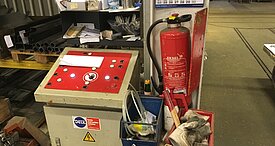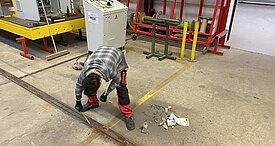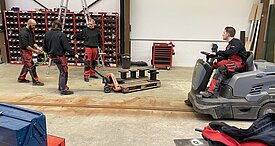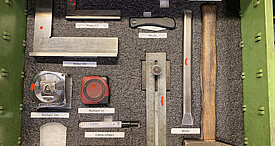Despite full capacity utilisation of production, the entire MINDA production division began introducing the 5-S method in September 2019. The aim was to simplify processes in the operational workflow within one year and to create more clarity, cleanness and clear structures. This should minimize stress at the workplace and create a good feeling.
5-S This means sorting, systematizing, keeping clean, standardizing as well as self-discipline & further development. In order to explain this method, Manuel Lehmann, as the external consultant of ML-Plus, trained the employees of the electrical and mechanical production. He explained the theory of the 5-S method to the colleagues in groups so that everyone could internalize it.
The participants experienced the workshop program in a comprehensible and practical way with numerous examples of how it should not be. Some found themselves in it and it was clear that something has to change. The individual modules of the method were then put into practice "step by step". The workplaces, tool trolleys, cabinets and processes in the production halls were examined in detail. Drawers were lined with foam and provided with cut-outs for the tools sorted by topic. All tools, materials and areas were labelled. Initial scepticism only disappeared when it became clear that one can now reach "blindly" into a cupboard and hold the right thing in your hand. One can quickly recognize if something is missing even before it is needed. However, it is also a precondition that this order is kept and that every tool and all materials are returned to their defined place.
The foremen Patrick Meier and Andre Kleinschmidt show with great pride that, for example, searching for lift trucks is stopped now. Each pallet truck has a fixed location and is colour-coded. After use it immediately becomes clear in which hall and at which location the car has to be returned. So it is at hand for the next use. This is just one example out of many. This also applies to forklift trucks, transport belts, the disposal of waste, etc.
Thus, all workplaces and the surroundings were clearly structured and delimited with a red ribbon. Time, which was often wasted by time-consuming searching, is now used in a more efficient way. "Anyone can work with any tool trolley and one can see on photos what is placed in a cabinet and in what order," the two foremen remark.
In order to keep alive the achieved order and the new structures, weekly tours take place now. Each area has got a responsible "godfather" who keeps an eye on existing material and, if necessary, restores this order.
Every morning, the foremen and employees meet at the four newly installed shop floor boards to discuss the daily tasks. There, information is passed on via short channels and every two weeks the production management is also involved. On the boards one can see who is working on which job, at which assembly workstation and who is out. Additional information such as hall responsibility and quality management is visibly displayed.
Even the coach appreciates the willingness of the colleagues to get involved in the massive changes at their workplaces. "The results are impressive and were created by the employees themselves. The company can be proud of this result!"
Manuel Lehmann reports with a smile: "I will never forget Eckhardt from the assembly division (a very nice welder). Friendly spoken, his enthusiasm was very limited at the beginning but when saying goodbye he paid me a compliment that I enjoy to remember: "Manuel, that wasn't so bad." A big praise, just typical East Westphalian style!
















